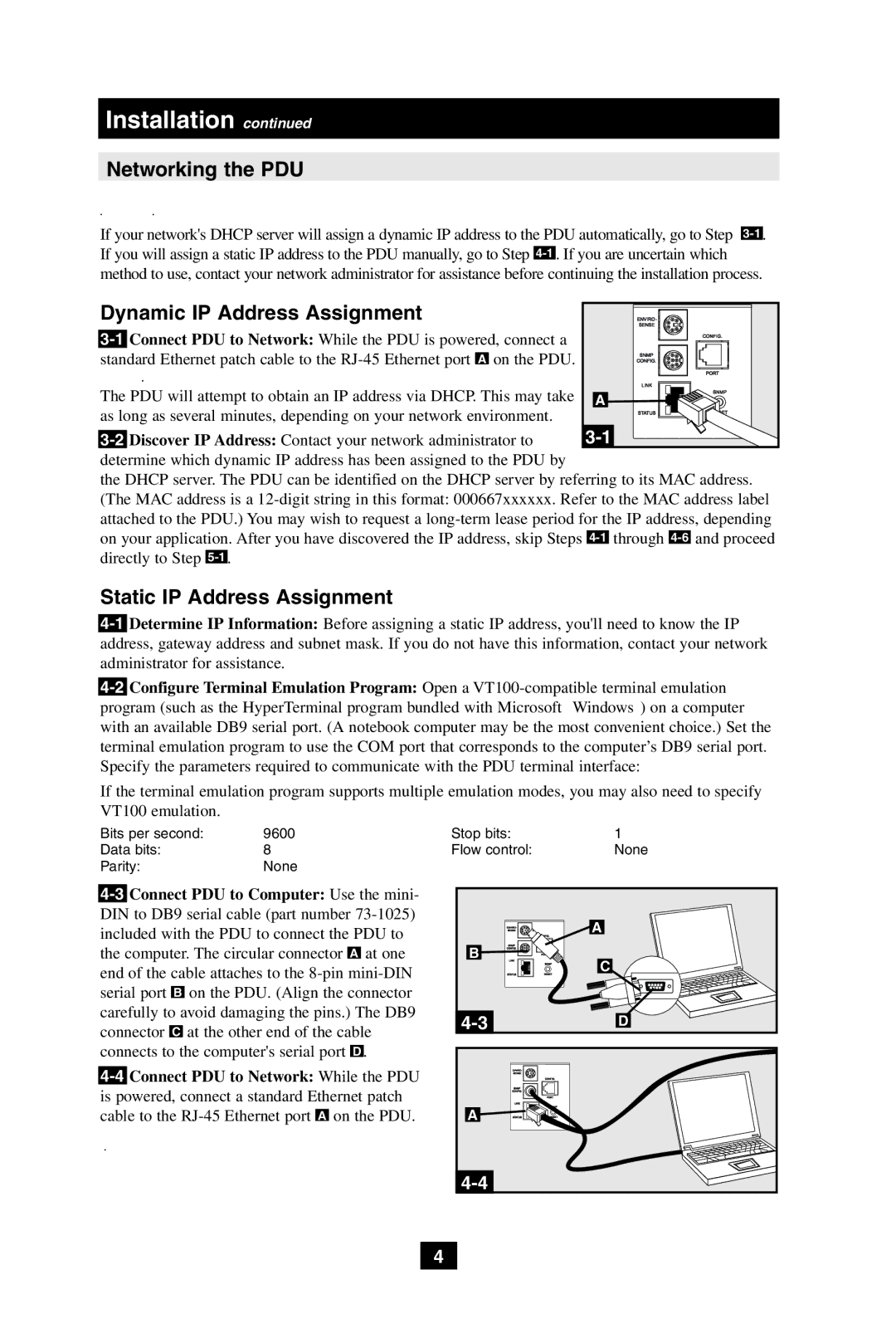3-1 .
Installation continued
Networking the PDU
Note: The MAC address of the PDU (a 12-digit string in this format: 000667xxxxxx) is printed on a label attached to the PDU enclosure. The MAC address is also printed on a label attached to the internal network card.
If your network's DHCP server will assign a dynamic IP address to the PDU automatically, go to Step  If you will assign a static IP address to the PDU manually, go to Step 4-1 . If you are uncertain which method to use, contact your network administrator for assistance before continuing the installation process.
If you will assign a static IP address to the PDU manually, go to Step 4-1 . If you are uncertain which method to use, contact your network administrator for assistance before continuing the installation process.
Dynamic IP Address Assignment | |
3-1Connect PDU to Network: While the PDU is powered, connect a | |
standard Ethernet patch cable to the RJ-45 Ethernet port A on the PDU. | |
Note: This port is not compatible with PoE (Power over Ethernet) applications. | |
The PDU will attempt to obtain an IP address via DHCP. This may take | A |
as long as several minutes, depending on your network environment. | |
3-2Discover IP Address: Contact your network administrator to | 3-1 |
determine which dynamic IP address has been assigned to the PDU by | |
the DHCP server. The PDU can be identified on the DHCP server by referring to its MAC address. (The MAC address is a 12-digit string in this format: 000667xxxxxx. Refer to the MAC address label attached to the PDU.) You may wish to request a long-term lease period for the IP address, depending on your application. After you have discovered the IP address, skip Steps 4-1through 4-6and proceed directly to Step 5-1 .
Static IP Address Assignment
4-1Determine IP Information: Before assigning a static IP address, you'll need to know the IP address, gateway address and subnet mask. If you do not have this information, contact your network administrator for assistance.
4-2Configure Terminal Emulation Program: Open a VT100-compatible terminal emulation program (such as the HyperTerminal program bundled with Microsoft® Windows®) on a computer with an available DB9 serial port. (A notebook computer may be the most convenient choice.) Set the terminal emulation program to use the COM port that corresponds to the computer’s DB9 serial port. Specify the parameters required to communicate with the PDU terminal interface:
If the terminal emulation program supports multiple emulation modes, you may also need to specify VT100 emulation.
Bits per second: | 9600 | Stop bits: | 1 |
Data bits: | 8 | Flow control: | None |
Parity: | None | | |
4-3Connect PDU to Computer: Use the mini- DIN to DB9 serial cable (part number 73-1025) included with the PDU to connect the PDU to the computer. The circular connector A at one end of the cable attaches to the 8-pinmini-DIN serial port B on the PDU. (Align the connector carefully to avoid damaging the pins.) The DB9 connector C at the other end of the cable connects to the computer's serial port D .
4-4Connect PDU to Network: While the PDU is powered, connect a standard Ethernet patch cable to the RJ-45 Ethernet port A on the PDU.
Note: This port is not compatible with PoE (Power over Ethernet) applications.

![]() If you will assign a static IP address to the PDU manually, go to Step
If you will assign a static IP address to the PDU manually, go to Step 